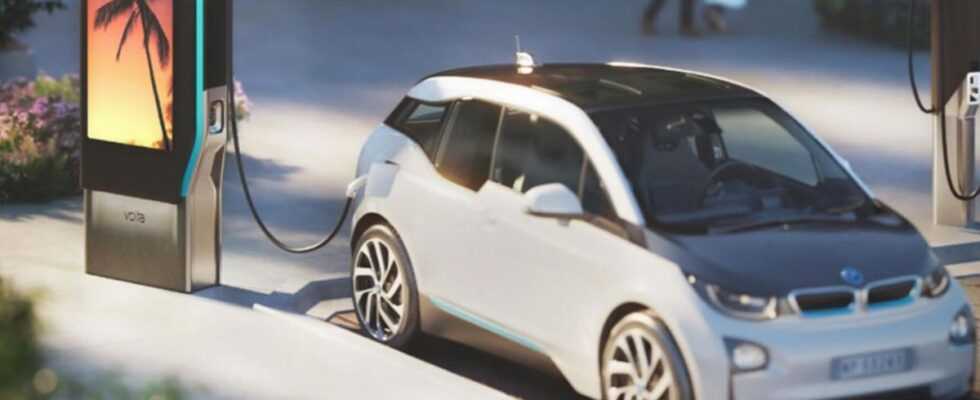5
What if the electric charging of your vehicle was “free”? This is the bet of Volta Charging, a new operator, which wants to install electrical terminals whose load is entirely financed by advertising.
Landing from the United States, Volta Charging has made a specialty of deploying electrical terminals whose charge is entirely paid for by advertising. Here, a kiosk installed in an Amazon Fresh parking lot, in California. @Volta Charging
During the last barometer published in December 2021 by Avere-France and the Ministry for Ecological Transition, France had 51,243 charging points – not to be confused with charging stations. Either one charging point for nine electric vehicles or one for fourteen if plug-in hybrid cars are included.
These charging points are distributed as follows: 18,880 (37%) are installed in car parks, 17,939 (35%) on the road, 13,200 (26%) in front of shops and 778 (2%) in businesses .
Distribution of charging points by installation site. @ Avere-France
The vast majority of these charging points are chargeable to owners of electric vehicles. Even those located in shopping center car parks are becoming so again. This is particularly the case at Ikea, and soon at Auchan and the shopping malls managed by Westfield. On the other hand, free access remains for the moment of setting at E.Leclerc and Lidl. The reason for this about-face is to be blamed on the insufficiently rapid return on investment in the eyes of certain investors, including these famous shopping centers.
Terminals not profitable enough
On the question of profitability, interviewed in 2019 by our colleague Éric Bergerolles from Challenges.fr, Michael Hajesch, general manager of the Ionity charging station network (consortium of several car manufacturers), declared that it would be necessary to “8 to 10 years of investment and development of its network to achieve financial profitability”. As Éric Bergerolles points out, “It was before the pandemic, the surge in copper prices, and the shortages of electronic components”.
Upcoming installation of Volta Charging charging station in the state of Virginia. @Volta Charging
Hence the idea of charging stations that would be self-financing thanks, in particular, to advertising. In any case, this is the bet made by Volta Charging, an American operator whose business is the installation of charging stations. “Where consumers live, work, shop and play”. With 11 years of experience and a deployment of more than 2,000 terminals in the United States, the company is landing in Europe, and more specifically in Germany, Austria, Switzerland and France.
Concretely, Volta Charging’s charging stations have two large digital screens – like what can already be seen in the metro and train stations – on which is displayed advertising. As a general rule, the terminals deployed by Volta Charging are as close as possible to the contributing brands and advertisers who hope to “Attract more customers, willing to stay longer at the catchment area”.
For the moment, the American operator refuses to communicate on the number of charging stations that will be put into service. On the other hand, he declares that he will be based on two pillars: “The penetration rate of electric vehicles and the dynamism of the outdoor advertising market”. Since January 2010, the French car fleet has counted 494,544 electric vehicles and 258,528 plug-in hybrids. The target being one million electrified cars (electric + plug-in hybrid) by the end of 2022 (Avere-France data).
Depending on the location, there are 22 kW (AC) terminals or fast terminals (DC) with charging power between 50 and 150 kW. The client will have nothing to do except connect. Volta Charging specifies that secondly, “The terminals will be interoperable, and will allow user identification and access with all badges”.
As for the problem of so-called suction cups, the operator told us “Study the options available to allow as many people as possible to access its offer”. Thus, among the solutions mentioned, it would be considered to interrupt the charging after a certain time or to make it pay if the charging station was “Untimely occupied”. Volta Charging should soon unveil the French regions where its charging stations will be installed.
Appearance of gratuity
However, it is worth remembering that the manufacture of a terminal, its installation and even more so the charging of electricity do indeed generate production costs. However, loading will only be free in appearance, insofar as there is necessarily an economic agent who finances the entire production cycle. And contrary to what one might think, it will be the user, direct or indirect customer of the advertiser’s products who finances these terminals and uses them as a vector of communication.

